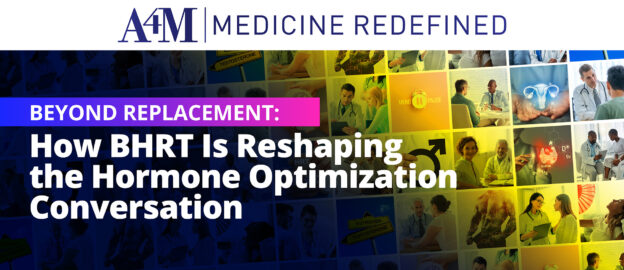In the rapidly evolving landscape of longevity and personalized care, bioidentical hormone replacement therapy (BHRT) is no longer a fringe consideration. It’s a core tool in the age management arsenal, particularly for clinicians committed to individualized, physiology-driven medicine. As new data sharpens our understanding of hormonal health, BHRT stands at the intersection of science, aging, and quality of life.
The upcoming BHRT Symposium (September 11–13, 2025) provides a timely opportunity to reassess how we’re integrating hormone optimization into clinical care, and what it means for the future of functional and regenerative medicine.
A Precision-Based Paradigm
Unlike conventional hormone therapy, which often relies on synthetic or animal-derived hormones, BHRT uses compounds structurally identical to endogenous hormones – such as estradiol, progesterone, and testosterone. These are typically derived from plant sources and can be tailored to individual hormonal profiles.
This personalized approach offers distinct benefits:
- Greater adaptability across patient presentations
- Improved tolerability in many individuals
- Potentially safer side effect profiles when properly monitored
However, the advantages of BHRT aren’t found in the label – they’re found in the methodology and monitoring. Clinical success hinges on a deep understanding of pharmacokinetics, metabolic pathways, delivery methods, and patient-specific risk factors.
Safety, Scrutiny, and the Role of Compounding
BHRT has sparked considerable debate, particularly around compounded formulations. While some patients report superior symptom control using custom-compounded BHRT, major bodies like the American College of Obstetricians and Gynecologists (ACOG) continue to raise concerns over quality control, dosing accuracy, and long-term safety.
A 2020 National Academies report emphasized that compounded BHRT lacks the same level of rigorous safety data as FDA-approved options. And yet, recent reviews such as Liu et al.’s 2022 systematic review of 29 RCTs, found no adverse impacts on lipid profile or glucose metabolism in cBHT users.
This dichotomy underlines a critical point: more research and regulatory alignment are urgently needed to guide clinicians through the nuanced terrain of compounded vs. FDA-approved BHRT options.
Menopause, Andropause, and Beyond
The traditional framing of hormone replacement therapy as a menopause-only intervention is outdated. Testosterone decline in aging men, estrogen imbalance in perimenopausal women, adrenal insufficiency, and thyroid dysfunction all represent areas where BHRT can play a powerful therapeutic role.
Moreover, there is increasing evidence that optimized hormone levels support cardiovascular health, brain aging, metabolic resilience, and mood regulation. In women over 65, for example, transdermal estradiol has been linked with reduced mortality and cardiovascular risk, according to recent population studies.
This expanded view of hormone care aligns with the A4M mission: to promote longevity that isn’t just measured in years, but in energy, cognition, libido, sleep, and vitality.
Clinical Training That Matches the Stakes
As BHRT becomes a central tenet of patient-centered aging protocols, clinicians need more than basic exposure – they need advanced, evidence-based training that accounts for testing accuracy, hormone interactions, pharmacogenomics, and legal considerations.
That’s why the BHRT Symposium is essential. Led by globally recognized faculty, the event will cover everything from case-based protocols to new diagnostic techniques and legal best practices.
This year’s curriculum is designed for both entry-level and experienced providers ready to take the next step toward hormone mastery in age management medicine.
Conclusion: A New Era for Hormone Medicine
The future of hormone optimization isn’t one-size-fits-all, and it certainly isn’t synthetic by default. BHRT offers an elegant, adaptable path forward, but only when applied with rigor, accountability, and clinical insight.
Whether you’re refining your protocols or building your BHRT foundation from the ground up, the 2025 Symposium provides the tools and community to do so with confidence.
Learn more or register today at A4M’s BHRT Symposium page.
Sources

